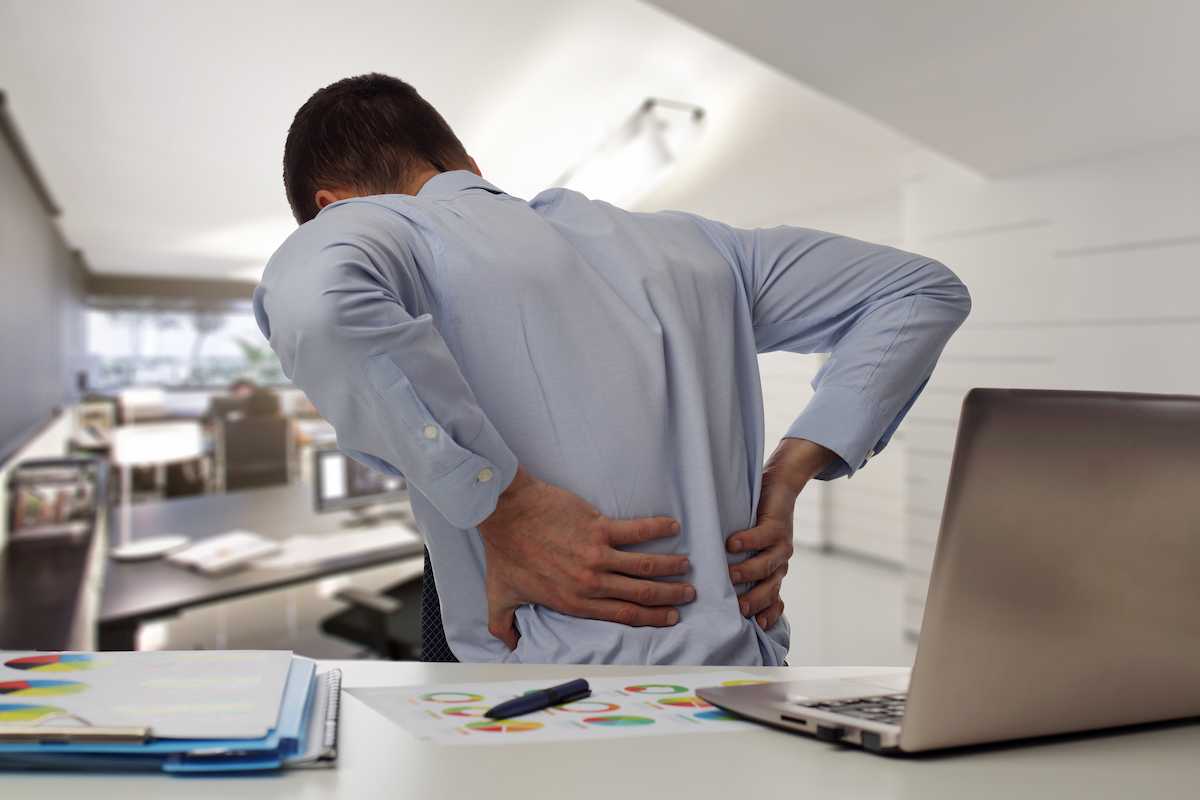Most people think of lower back injuries as a sudden traumatic event that occurs while lifting, bending, or twisting. This is sometimes the case, but more often lower back injuries occur due to microtrauma – small, repetitive injuries over time. In this post, I aim to help you strengthen your low back and give you tips on how to avoid or lessen low back pain episodes before they occur.
According to the U.S. Bureau of Statistics, office and administrative occupations make up the largest group of workers in the United States. This means that most people in the US are spending a large portion of their day sitting. Another study done by the U.S. Bureau of Statistics showed that most of these jobs required employees to sit for nearly 40% or more of the workday. The workplace isn’t the only place where people sit. After work, people relish the opportunity to plop down on the couch and settle in for the evening, or they go out with friends and sit around a table together.
So why would sitting all day cause a problem? Sitting seems like a fairly harmless position right? It seems like we aren’t putting any abnormal stress on the body such as lifting and twisting. Well, the human body isn’t primed to be in this position all day.
Most people are sitting 6 to 13 hours a day. Our bodies are meant to run, jump, climb, and lift. This is a lot different than the vast majority of people today, who spend long hours sitting during the day. Even most athletes tend to sit when they are not actively training.
So why is sitting an issue?
When individuals are spending 6-13 hours a day sitting, they are not using muscles in areas that are important for spine stability and support. The old saying, “you use it, or you lose it” applies well in this case. Not only are muscles important in spinal stability getting weaker, but muscles that aren’t very good at spine stabilization are also getting tightened, leading to feelings of stiffness.
Combating these effects can seem like a daunting task based on the complexity of the issue. Here are 4 easy tips you can implement into your daily routine today to help you get started.
EASY TIP 1: Abdominal Bracing
 Abdominal bracing is a strategy that helps us stiffen and strengthen our low back by using the muscles in our abs. Having a strong and stable core is one of the best strategies that people can use to avoid lower back injuries. Sit-ups aren’t the best approach to getting a strong and stable core that can help protect us against injury. (To read why, check out our Stable Core post by scanning the QR code or clicking on this link.) Having a strong muscular brace is much like a canister for tennis balls. Without the canister, the tennis balls would be unstable. If you remove the muscular brace, you will remove the stability of the spine, much like the tennis balls without a canister.
Abdominal bracing is a strategy that helps us stiffen and strengthen our low back by using the muscles in our abs. Having a strong and stable core is one of the best strategies that people can use to avoid lower back injuries. Sit-ups aren’t the best approach to getting a strong and stable core that can help protect us against injury. (To read why, check out our Stable Core post by scanning the QR code or clicking on this link.) Having a strong muscular brace is much like a canister for tennis balls. Without the canister, the tennis balls would be unstable. If you remove the muscular brace, you will remove the stability of the spine, much like the tennis balls without a canister.
Here are three easy exercises you can do at home with no equipment to learn how to brace effectively.
Side Bridge
Begin on your side with one elbow on the floor. Either with your knees bent or legs straight, raise your hips up off of the floor and hold for 7 seconds. Return to the floor and repeat for 7 times. You can see our Side Bridge video on our YouTube channel here.
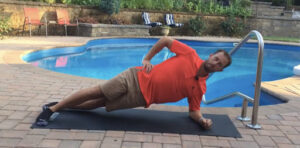 |
|---|
3 Month Supine
Begin on your back with your legs bent at 90 degrees at the hips and knees. Brace through your abdomen while moving your legs and then your arms. You can alternate movements of the arms and legs in a dead bug-like movement. See this exercise performed in our 3 Month Supine video here.
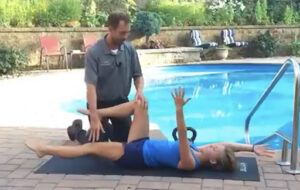 |
|---|
Bird Dog
Start this exercise by being on all fours with a braced and flat lumbar spine. Alternate sliding each arm and leg out, keeping the back stable and unmoving. You can see the entire exercise by clicking on the link here.
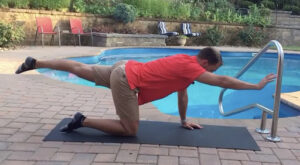 |
|---|
EASY TIP 2: Work Breaks (AKA Movement Breaks)
Interrupting our work can be very beneficial! We recommend taking 5 minutes each hour to take a short walk, do a stretch or two, and grab a drink of water. A short break every hour or so can improve productivity because it allows us to refocus our energy and movement helps our brains process information. Here are my favorite two stretches to do as a work break:
Lunge Stretch
Start with one knee down on the floor and stretch into the movement by pushing your hips to the floor. You can likewise take your arm up over your shoulder to increase the stretch of the hip flexor and low back muscles. You can see our YouTube video of the Lunge Stretch here.
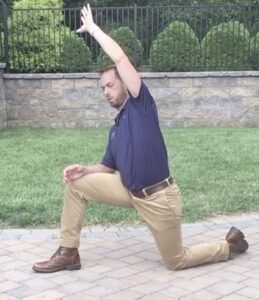 |
|---|
Doorway Stretch
Stand in a doorway with your hand on the door frame. Lean through the door and look away from the door frame to feel the stretch in the pectoral and bicep muscles. Even though the exercise targets the upper body it will help the low back by decreasing shoulder slump. This will decrease the compressive load on the low back that excessive shoulder slump and poor posture create.
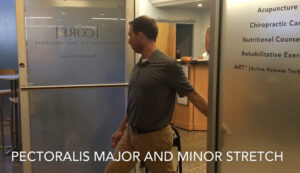 |
|---|
Five minutes is all that you need, and you don’t even need to do all five minutes at once. Just doing these stretches a little bit here and there throughout the day will add up to a positive improvement over time. Just a few minutes a day can help prevent low back pain!
EASY TIP 3: Thoracic Mobility
The thoracic spine is the part of your spine where your ribs are. Most of us have 12 vertebrae in this region that all move in three directions. For us to press overhead and do all the fun movements we do, we must have adequate motion in the t-spine. Having adequate t-spine mobility allows us to bend through the part that should be bendy while stiffening the part that’s supposed to be stiff – your low back. If you find that you don’t have enough movement through your t-spine try the exercises found in our blog from a few years back, “How the mid back causes low back and neck pain.”
Foam Roller Extension
Lay on a foam roller perpendicular to the thoracic spine. Lift your hips up off of the floor and roll back and forth over the thoracic spine. Continue rolling for 30 seconds or more.
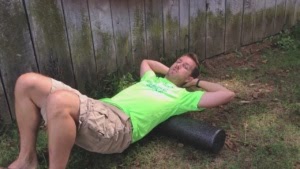 |
|---|
Bruegger’s Stretch
Stand upright and very tall. Roll your thumbs backward rotating your shoulders into a retracted position. From this position breath in and out slowly. Hold for 30 seconds with several breathing cycles.
 |
|---|
EASY TIP 4: Strengthen muscles weakened due to sitting.
When we sit, the large muscles that move our hips – our glutes – are not being used. Over time this can lead to weakness and poor control of those muscles. When this happens, our ability to use our hips to lift and move things is reduced, and most people will compensate by using their backs to lift, which is not good. These simple exercises don’t require any equipment and can strengthen your butt muscles.
High Oblique Sit
This exercise can be performed by kneeling on one leg. Slightly open your stance with the other leg’s foot flat on the ground. With a small oblique angle, sit back through the hip, travel down and back as far as you feel comfortable, and then return to the kneeling position. Repeat this 5-10x per leg. This exercise can be found on our YouTube channel here.
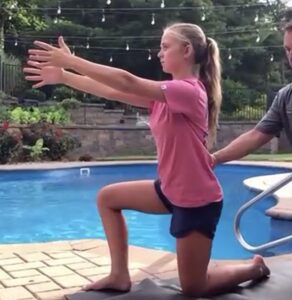 |
 |
|---|
Hip Hinge
Kneel on both knees with your spine and posture as tall as possible. Maintain good posture while you sit back towards your feet and rise back up again. The hinge will target the muscles surrounding the hip joint that become weak very easily with prolonged sitting. Repeat this 10-15x. This exercise can be found here.
 |
 |
|---|
We’ve outlined a few simple tips and given you a few exercises, all of which don’t require any equipment, that can help you prevent low back pain. With less than 10 minutes per day, you can be on your way to living a better, more mobile, and stronger life!
If you do experience low back pain, always have it evaluated by a professional. If you need some help, we are here for you. We would love to help you become healthier than you have ever been!

Daryl C. Rich, D.C., C.S.C.S

